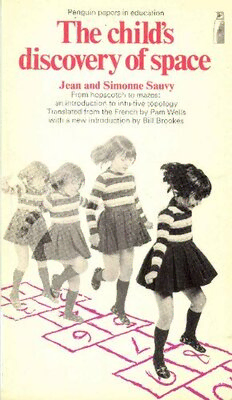Table Of ContentThe childs |
discovery ofspace
Jean and Simonne Sauvy
From hopscotch to mazes:
an introductionto intuitive topology
Translated from the French by Pam Wells
with a new introduction by Bill Brookes
mere og) OSL [2 Ib
The Child’s Discoveryof Space
JeanandSimonneSauvy
The Child’s Discovery
of Space
From hopscotch to mazes:
an introduction to intuitivetopology
Jean and Simonne Sauvy
TranslatedbyPamWellswithan
introductionbyBillBrookes
Penguin Education
PenguinEducation
ADivisionofPenguinBooksLtd,
Harmondsworth,Middlesex,England
PenguinBooksInc,7110AmbassadorRoad,
Baltimore,Md21207,USA
PenguinBooksAustraliaLtd,
Ringwood,Victoria,Australia
PenguinBooksCanadaLtd,
41SteelcaseRoadWest,
Markham,Ontario,Canada
PenguinBooks(N.Z.)Ltd,
182~190WairauRoad,Auckland10,NewZealand
FirstpublishedinFrancebyEditionsCasterman,1972
FirstpublishedinGreatBritainbyPenguinEducation,1974
Copyright©EditionsCasterman,1972
Thistranslationcopyright©PenguinEducation,1974
Introductioncopyright©BillBrookes,1974
MadeandprintedinGreatBritainby
C.Nicholls&CompanyLtd
SetinMonotypeTimes
Thisbookissoldsubjecttotheconditionthat
itshallnot,bywayoftradeorotherwise,belent,
re-sold,hiredout,orotherwisecirculatedwithout
thepublisher’spriorconsentinanyformof
bindingorcoverotherthanthatinwhichitis
publishedandwithoutasimilarcondition
— includingthisconditionbeingimposedonthe
subsequentpurchaser
Contents
Introductiontothistranslation 7
Authors’preface 17
1 Topologyandthedevelopmentofthechild’sintelligence 21
2 Therealmoftopology 27
3 Exploringtheworldoftopology:linesandsurfaces 31
4 Exploringtheworldoftopology:volumes 57
5 Topologicalmapsanddiagrams 62
6 Fromsetsofpointsto‘abstracttopologicalspaces’ 85
Conclusion 91
References 93
Furtherreading 95
Introductiontothistranslation
Children learning mathematics in the early years ofschool are
introduced to numbersas a principal activity. They learn tech-
niques for handling, using and applying numbers which have
developed overseveralhundredyears, and thestrength ofthese
traditional techniques springs directly from the actual control
thattheygiveovertheenvironment.
The basic element in the power ofnumber is uniqueness of
succession; given some objects arranged for counting, then, no
matterhowtheyarecounted,weshallalways arriveatthesame
finalnumber.Ifthisuniquecorrespondencedidnotexistthenwe
shouldneverhavethatsimplicityoforderingwhichfinallyallows
usconservationofnumber.
This seems obvious, yet those ofus who have workedclosely
withyoungchildrenknowtheimmensevarietyofwaysinwhich
theycometotermswiththislevelofhandlingofnumber.Tobe-
gin to understand the reasons behind this variation, we could
look at those experiences thought to be necessary forcounting
todevelop.Forinstance,whatismeantbythephrase‘someob-
jectsarrangedforcounting’?Surely, allobjectsarearrangedfor
counting in some way or another? In order to decide whether
theyareindeedarranged ornot, weshouldbegintolookatob-
jects and how they appear: battery hens, pigs in sties, cows in
fields,antsinanest....Therelationshipofplacetoobjectseems
to be part ofthearrangement. We haveto be aware ofcertain
kindsofconnectionsbeforewecanbecertainaboutcounting.
Asixyear oldoutinthecountryforapicnicwentofftocount
thecars.Hedidthisveryquickly.Hewasthenaskedtocountthe
people, but declined, sayingthat ‘they wouldn’t be inthesame
place’.Whenaskedwhathemeant,hereplied,‘Supposesomeone
wasthereandyoucountedhimandthen hewentawayandsome-
oneelsecamethere,youwouldn’tcounthim.” Thesixyearold’s.
abilitytodifferentiatecountableobjectsandnoncountableobjects
8 Introductiontothistranslation
isconnectedwithhisperceptionoftherelationshipsbetweenthe
partsofspacetowhichhisattentionhasbeendrawn.
Thepowerandsimplicityofcountingsometimesmakesusover
eager to see it as an achievement. It seems so obvious and we
thereforetendtojudgeitsachievementbycertaincharacteristics.
Whenyoungchildrenrecitethenumbernames1,2,3, 4,..., in
theircorrectorderandanindexfingermovesattherightmoment
foreachsounduttered, wecanrecognizeakind ofcontrol. Un-
fortunately, ifatthesametimethechild’sfingerdoesnotcorres-
pond withtherow ofbuttons that wehaveput out forhim, we
oftenreactbysaying ‘Hecan’t reallycountyet.’ Withthisstate
ofdevelopment, there is no doubt that the child recognizes for
himselfsome characteristic ofthe uniqueness ofcounting even
thoughhecannot,atleastintheinstancestheteachersees,apply
ittoobjectsoutsidehimself.
During the period when children are learning to count, they
experience the world in a wide variety of ways. Some of these
waysarerelevant tocounting, someare not.Whichare import-
ant?Towhom?Toachildconsciousofthecomplexityofmaking
patterns,countingthearrangementsmaybeirrelevant.Ifcounting
onlyappearstohimasoneofthemanywaysofseeingtheworld,
thenheis as likely to choose other patterns as he is to choose
the appropriate one. Whatwillmakecounting patternsimport-
ant? |
Usuallyweattempttomaketheactofmeasuring,orcomparing
insomeway,amotiveforexperiencingcounting.Whohasmost?
Least?Whoistaller,heavier?Whohasmostpocketmoney?We
use the possession ofproperty, buying andselling to develop a
strongmotivationtocount. This is notsurprisingin oursociety
and it shouldnotbesurprisingto discoverthat, where asociety
hasnoproperty,thereisnocountingeither!Aclosestudyofsuch
societies, for example some aborigine tribes in Australia and
certaintribesinAfrica,reveals thisfact. Yetthesesocieties sur-
viveandhencemustinsomewayexerciseacontrolovertheirown
interrelationshipsandtheirphysicalenvironment.
Itisclearthatskillsinhandlingnumbersareimportantforus,
butoursocietyisgrowingmorecomplexandtherearesignsthat,
Introductiontothistranslation 9
inthedrivetohandlenumbersefficiently,weareexcludingmeth-
ods ofcontrolwhichwesorelyneedto dealwiththis increasing
complexity.
Thebasiccharacteristicofnumberisthatofuniquesuccession.
With an increasing numberofsituations where the connections
thatwehavetomakeareneitheruniquenorsimplyordered, we
mustlookoutforothermeans.Itisnolongerpossibleforaper-
sontoavoidbeinginvolvedwithotherpeopleinalargenumber
ofdifferent ways. Theseways differin qualityand ourabilityto
survive will, in theend, depend on howskilful wearein dealing
with relationships at a large number of differing levels. The
child’s world is no longer a simple immediate world as, for in-
stance, he can now have the experience ofan active TV screen
fromaveryearlyage.
Justasourabilitytocountcaneventuallyleadtohighlyskilled
methodsofcontrol,soitcanbearguedthatincreasinglymorein-
sight will be needed into the quality oftheconnections thatcan
bemadeintheworldinordertosurvive.
Jean and Simonne Sauvy are deeply concerned with these
developmentsandwithhowchildrengrowandlearn. Theirwork
is based on the Decroly School, near Paris. This experimental
schoolwasestablishedaftertheWarandis aplacewhereteach-
ers havecooperated in developingmethods ofworkappropriate
tochildrentoday.InthisbooktheSauvysofferoneexplanationof
elementarytopologicalideas,involvingsimplenotionsofconnec-
tion,neighbourhoodandconsequentialdevelopments.Infollow-
ingchildrenastheyexplorespace,wecanseetheworldinwhich
theylearntocount,toconnectobjectsandtodistinguishdifferent
waysofconnection.
Butthroughout,theaimofthisbookistoencouragepeopleto
think of space in new ways. In everyday life the word ‘space’
seemsto be used fortwo quite different ideas. When peopleare
asked what theymean byspace, theyusuallyanswerintermsof
vastness, space travel, extending out from the Earth’s surface,
wideopenvistas....Thisisanaturalresponseandthereaderwill
feelsomesympathyfor the notion ofspace as large and empty.
Thereisanotheruseof‘space’whichisrarelymentioned,probably
10 Introductiontothistranslation
because it is a much more prosaic use of the word. Its use is
illustrated bysuch phrases as ‘Make a space for me’, ‘Is there
anyspace?’ ‘Watchthisspace’, ‘Spaceouttheplants!’, ‘Check
thatthereisenoughspace’,‘Makesomemorespace’,andsoon.
Thisis a verydifferentuse ofthewordand weusuallyassociate
someactivityorotherwitheachofthephrases.
Itisnotsurprisingthat,whenasked‘Whatdoyouthinkspace
is?’, peopleanswerwiththemoreintangiblenotion ofvastness,
becausetheyarebeingaskedforadescriptionandofferthemost
generaldescriptionofspacethattheycanthinkof.Itisnotimme-
diatelyobvioushowtodescribethespaceorspacesthatarerefer-
redtointhesecondsense,for,eachtimeitisused,itwillbelinked
withtheassociated activity—gardening, sittingaround,carpar-
king,advertising,organizingmeetingsandsoon.
Thedifferences betweenthetwo meanings havebeen stressed,
butwhat, bycontrast, do theyhaveincommon?Bothareasso-
ciated with emptiness, but this creates problemsas it is one of
those ‘something-for-nothing’ words. The other day someone
remarkedontrivialincidentbysaying‘Hethrewanemptybag
ofnuts atme’. Atfirst sightit seems that theslightlyridiculous
notestruckbythis sentenceshouldbechanged. But, ifonesug-
gests ‘He threw a bag at me’, this would not be an adequate
description. Whatabout ‘a paper bag’? Even here there would
stillbeatemptationtoask‘Wasthereanythinginit?’. Sowere-
treattosaying ‘Hethrewanemptypaperbagatme’. Nowit is
unclearwhatkind ofpaperbagso ‘Hethrewatmeabagwhich
usuallyholdsnuts, butwhichin thiscasewasempty.’Ithinkin
theendIprefertheobviousambiguityofan‘emptybagofnuts’.
Allthephrasesusedearliertodescribespacecomefromspecific
situationsinvolvingquitespecificactions.Theirusepointstoour
definingaspaceforeachaction. Theactionitselfwilldefinethe
space.Thecarparkisasimplydefinedandlimitedspaceinterms
ofcarsbeingparked. Ifitwas usedforagameoffootballwhen
notbeingusedasacarpark,thenitwouldbeadifferentspace.
Wecancontinuetothinkofactionsdefiningspaceandthiscan
beveryhelpful,butourideaofspacehasbecomedistortedaswe
havelearnttomeasure. BythisImeanthatwecannowthinkof
Introductiontothistranslation 11
lengths, areas and volumes and this gives us a definite idea of
spacebeingidentifiedbymeasurements.Thisisusuallydonefora
practicalpurpose,butwehavebecomesousedtoknowingabout
measurementsthatwethinkthisiswhatspaceisabout.
Thisseemstobeathirdwayofthinkingaboutspacewhich,in
reality,istheconsequenceofgeneralizingaparticularformofthe
second,concernedwithaframeworkinwhichthingscanbedone.
The making of this framework in terms ofcommon measures
developedfromthetimeswhensuchactivities,whichnowrelyon
common measures, demanded their own frameworks. It is diffi-
cult, for instance, to ask now whether the idea of length (as
number) came before or after the invention of the measuring
ruler. Measuringappearsto beawayofdealingpracticallywith
many different situations, but there are still far more activities
undertakenwhichdonotrelyon formal measurementthanthose
thatdo.
This book deals with matters that reveal themselves more by
investigation and thinking than bylearningsome simple techni-
calskillssuchashandlingaruler;butthetechniques,asaconse-
quence of what is introduced, are not acquired immediately.
Herewearemoreconcernedwiththataspectofspaceconcerned
withmovement andpossiblyhavingsomerulesformoving. For
example, in a game ofchess, the ‘moves’ ofthe pieces and the
pawnsgiveaframeworktothegamedescribingwhatcanhappen
andmakingthegamepossible.Theagreementbetweentwopeople
toplayisanagreementthatexistsforthedurationofthegamein
the space governed by the rules. It is easy to see that all formal
gamesare like this and perhaps the idea canbe extendedtoless
formally defined activities, which individually show constraints
that both defineand allow. Writingis suchanactivitywhere, in
one sense, a piece ofpaper provides the space, theliving room,
forthewriter,butinamorecomplexwaythewriterisheldbyhis
skillandinthis‘agreement’hedemonstratesthespaceoftheskill
ofwriting. Also in a very rich sense we both exist in space and
makespace.Theactorwhomovesonthestageinsuchawayasto
engagetheaudience in imaginativeresponses, making the scene
fullerandmorevivid,isaddingtothesimplenotionofthemea-

